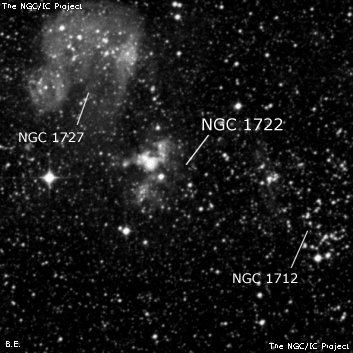
James Dunlop probably discovered NGC 1722 = D 112 = h2689 on 24 Sep 1826 with his 9" reflector and described "a very pretty small double nebula; very nearly equal; distance about 12" or 15"." He made 2 observations and his position is 7' too far SE. JH made three observations beginning in Dec 1834 and describing "F; S; R (Sky Hazy)". On a second sweep he recorded "pB; S. A knot of clustering stars." On his last sweep, he noted "The second of a series of clustering patches." Herschel did not reference Dunlop's possible earlier observation. NGC 1722 is plotted as an planetary nebula (since the IC description for IC 2111 is "Planetary, Stellar") on the Skalnate Pleso "Atlas of the Heavens" as well as the Sky Atlas 2000.0
400/500mm - 18" (7/10/05 - Magellan Observatory, Australia): NGC 1722 is part a small group of LMC clusters with nebulosity (LMC-N79) including NGC 1712 and NGC 1727. At 128x it appeared as a fairly faint, irregular hazy region with a few resolved stars and highlighted by IC 2111, a small, bright knot. The nebulosity has a good response to the UHC filter. Located 4' SW of NGC 1727. This is a very young open cluster with an unevolved main sequence and forms the eastern component of stellar association LH 2.
18" (7/9/02 - Magellan Observatory, Australia): the second of a trio of LMC clusters and nebulosity at 128x and UHC filter. At the core is a small, bright 15" knot = IC 2111 and surrounding this is a larger 2'-3' group of faint haze and some stars. NGC 1727 lies 4.5' NE and NGC 1712 3.9' SW.
Notes by Steve Gottlieb